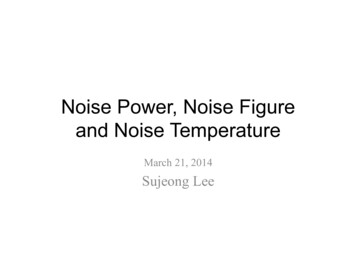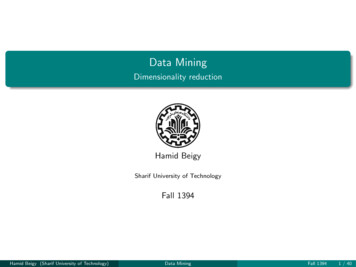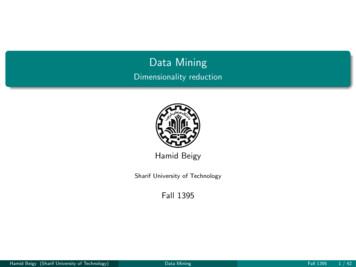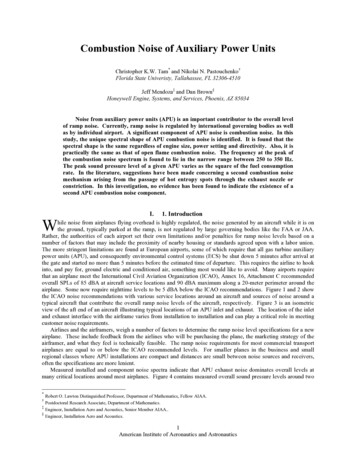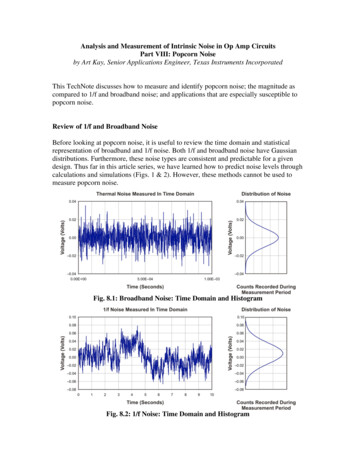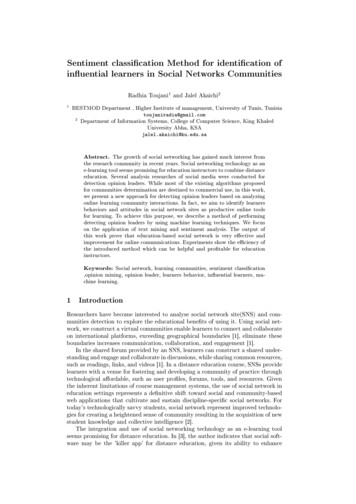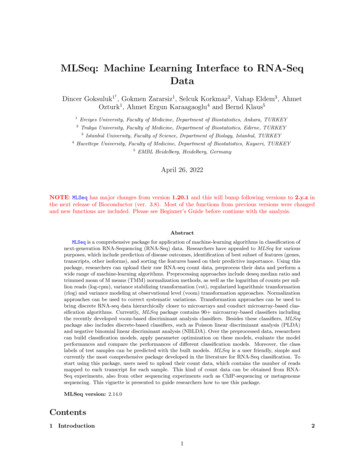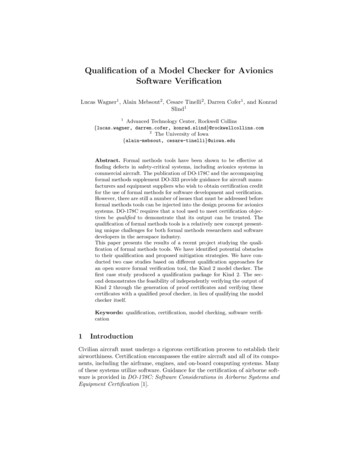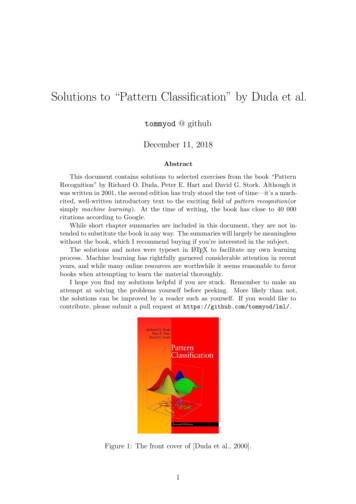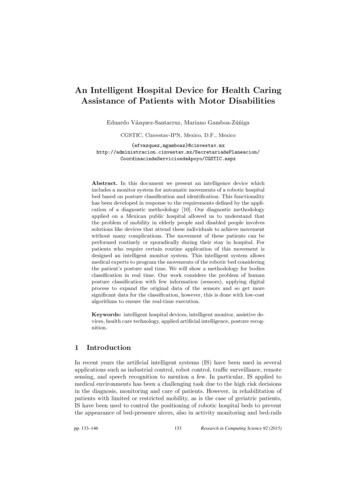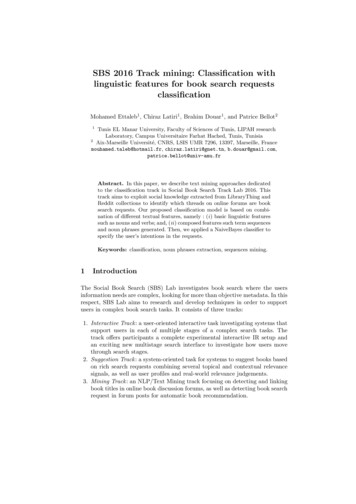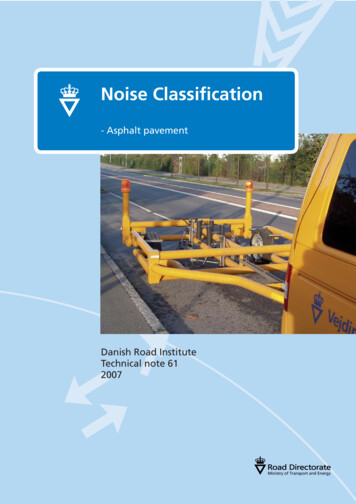
Transcription
Noise Classification- Asphalt pavementDanish Road InstituteTechnical note 612007Ministry of Transport and Energy
Road DirectorateGuldalderen 12DK-2640 HedehuseneDenmarkTelephone 45 7244 7000Telefax 45 7244 7105www.Roadinstitute.dkTitleNoise Classification- Asphalt pavementDatedOctober 2007EditorJørgen KraghPublished byRoad Directorate, Danish Road InstituteCopyrightRoad Directorate, All rights reservedPhotoBent AndersenPrintElectronicISBN electronic978-87-92094-20-9Reports published by the Danish Road Directoratecan be requested from the bookshop:Telephone 45 4322 7300Telefax 45 4363 1969e-mailschultz@schultz.dk
Noise Classification- Asphalt pavementJørgen KraghDanish Road InstituteTechnical note 612007Ministry of Transport and Energy
xx
ContentsPreface . 5Forord . 6Summary . 7Sammenfatning . 81. Introduction . 92. Guide to the use of asphalt surfacings in traffic noise abatement. 103. System for the declaration of the noise reducing properties of an asphaltsurfacing . 123.1 Basis . 123.2 Reference values . 133.3 Declaration in noise classes. 144. Noise measurements of test sections for the documentation of the noisereducing property. 185. Requirements on supplementary calibration of the measuring device (fieldcalibration) . 196. The noise declaration issued by the contractor. 217. Paradigm for use in contracting and preparation of tender documents inregard to bituminous surfacings exhibiting noise reducing properties . 227.1 Introduction . 227.2 Special specifications for noise reducing surfacings (SRS) . 238. Follow up on the 1st generation system . 27Annex 1 Danish addition to ISO/CD 11819-2 . 29Annex 2 Field calibration. 31Annex 3 Paradigm of the noise-declaration form. 323
4
PrefaceIn the modern world noise has a great impact on the human environment. Road trafficnoise represents a significant part of the total noise level. Noise abatement using traditional means such as noise barriers, walls or speed regulation is often the solution chosen. However, using asphalt surfacings exhibiting noise reducing properties representsan efficient measure for noise abatement that can be used either alone or in combination with other measures.Until recently asphalt surfacings with noise reducing properties have been used ona trial basis only. However, there is growing interest to use these asphalt surfacingson a wide scale. With the objective to work out procedures and documentation forcontracting asphalt surfacings with noise reducing properties, a task group has beenestablished under the Danish Road Directorate (DRD) as an ad hoc group to RoadSpecification Working Group U.21: “Asphalt Works”. In the following the task groupis named the SRS group.The SRS group got the task to work out a proposal for a 1st generation system for thespecification and documentation of asphalt surfacings exhibiting noise reducing properties. It is presupposed that the system should be able to ensure consistent measurement, evaluation and documentation of the noise reducing properties of individualasphalt surfacings.The SRS group initiated its work February 17th 2006 and finalised its proposal in thefall of that year. The proposal is presented in this report. The SRS group has in itswork used experience obtained from Danish trial sections and noise measurementprograms and used experience obtained from international investigations, first of allfrom the Netherlands and from the SILVIA program.The SRS group has representation from road authorities, industry and consultantsas follows. Peter J. Andersen, Danish Road Directorate (Chairman)Tony Andersen, Danish Road DirectorateOle Olsen, Danish Road DirectorateJørgen Kragh, Danish Road InstituteCarsten Bredahl Nielsen, Danish Road InstituteHans Christian Korsgaard, Grontmij Carl Bro A/SOle Grann Andersson, Skanska Asfalt I/SJørn Bank Andersen, NCC Roads A/SMikael Thau, LOTCON (Secretary)The group produced a report in Danish. The present note has been edited by JørgenKragh, based on a reworked translation of the report made by Mikael Thau.5
ForordStøjen er den miljøfaktor, som påvirker flest mennesker i hverdagen, og trafikstøjentegner sig for en meget stor andel af det samlede støjbillede. Trafikstøjen kan bl.a.reduceres ved at opføre støjvolde, -skærme eller –mure, eller ved isolering af berørteboligers facader, men den kan også bekæmpes direkte ved kilden, ved at anvende støjreducerende slidlag. Der er et udbredt ønske om at kunne anvende støjreducerende belægninger i bredere forstand end hidtil, hvor det mest har haft forsøgsmæssig karakter.Med den målsætning at udarbejde retningslinier for udbud af støjreducerende belægninger er der i et samarbejde mellem vejmyndigheder, industri og rådgivere nedsat engruppe med det opdrag at udarbejde forslag til et 1. generationssystem for udbud ogdokumentation af slidlag med støjreducerende egenskaber. Systemet skal kunne sikreensartet måling, tolkning og dokumentation af støjreducerende slidlag.Gruppen benævnes i det følgende SRS-gruppen, hvor SRS står for støjreducerendeslidlag. SRS-gruppen indledte arbejdet den 17. februar 2006 og har efterfølgende udarbejdet et forslag til et 1. generationssystem. SRS-gruppen har i sit arbejde anvendtindhøstede erfaringer fra tidligere udførte danske forsøg samt udenlandske erfaringerførst og fremmest gennem SILVIA projektet og hollandske erfaringer.SRS-gruppen har følgende repræsentation: Peter Andersen, Vejdirektoratet (formand)Tony Andersen, VejdirektoratetOle Olsen, VejdirektoratetJørgen Kragh, Vejteknisk InstitutCarsten Bredahl Nielsen, Vejteknisk InstitutOle Grann Andersson, Skanska Asfalt I/SHans Christian Korsgaard, Grontmij Carl Bro A/SJørn Bank Andersen, NCC Roads A/SMikael Thau, LOTCON ApS (sekretær)Gruppen har udarbejdet en vejregelforberedende rapport på dansk. Nærværende notater redigeret af Jørgen Kragh med udgangspunkt i en bearbejdning og oversættelse afrapporten foretaget af Mikael Thau.6
SummaryTraffic noise is essential for the health and well-being of people in the modern societyand it has during recent years attracted growing attention in Denmark. The effects ofthis important type of noise can be mitigated by means of noise barriers or screens butit can also be attenuated directly at the source by applying a noise reducing wearingcourse. Danish road authorities in conjunction with industry and consultants haveworked out a system for the specification and documentation of noise reducing asphaltpavement. The system is based on the Close Proximity Method (CPX) and encompasses: A guide to the use of asphalt surfacings in traffic noise abatement. A system for the documentation and declaration in classes of the noise reduction ofthe asphalt surfacing. Three classes A, B & C, where class A surfacings exhibit the highest noise reducing effect and class B & C exhibit lower noise reducing effects as compared toregular dense graded asphalt surfacings. Reference values of the noise emission as determined by the CPX method. Description of the CPX method including the definition of method variables andrequirements on supplementary calibration of the measuring device. Paradigm for use in contracting and preparation of tender documents.The system is a first attempt in Denmark for contracting noise reducing asphalt surfacings. The system has some limitations and several subjects need to be addressed in thefuture development of the system. Especially there is a need for better knowledge onthe accuracy offered by the CPX method, and for the development of appropriate acceptance criteria to be used in contracting.7
SammenfatningTrafikstøj er en væsentlig faktor for menneskers velfærd, og har igennem de seneste århaft stor opmærksomhed i Danmark. Trafikstøjen kan reduceres ved opførelse af støjvolde, -skærme o.l., men den kan også bekæmpes direkte ved kilden, ved anvendelseaf støjreducerende slidlag (SRS).Med den målsætning at udarbejde retningslinier for måling, dokumentation og udbudaf støjreducerende belægninger er der i samarbejde med vejmyndigheder, industri ogrådgivere udarbejdet et 1. generationssystem for udbud og dokumentation af slidlagmed støjreducerende egenskaber. Systemet er baseret på såkaldt CPX-måling af støjennær ved standardiserede referencedæk og består af: En vejledning om brug af støjreducerende asfaltslidlag til at bekæmpe trafikstøjen Et system til dokumentation og deklaration af støjdæmpende slidlag i støjklasser Tre støjklasser A, B og C, hvor slidlag i støjklasse A giver den største støjreduktionog klasse B og C giver mindre støjreduktion sammenlignet med almindelig tætgraderet asfaltbeton Referenceværdier for støjudsendelsen målt efter CPX-metoden En beskrivelse af CPX-metoden, herunder definition af variable i metoden og kravtil supplerende feltkalibrering af måleudstyr Paradigme til brug ved udbud og i kontrakter.Systemet er et 1. generationsforslag til et grundlag for udbud af støjreducerende asfaltbelægninger. Systemet har nogle begrænsninger og der er adskillige aspekter somskal undersøges i den videre udvikling af systemet. Især er der brug for mere viden omnøjagtigheden af CPX-målinger til brug for fastlæggelse af kriterier for accept af modtagne leverancer.8
1. IntroductionTo make proper use of asphalt surfacings exhibiting noise reducing properties it isnecessary to develop procurement methods to be able to describe the required noiserelated property and to evaluate bids from the contractors during a tender. The 1stgeneration system for specification and documentation of asphalt surfacings exhibitingnoise reducing properties described in this report represents a proposal to develop suchprocurement methods.The system contains a guide on how to use asphalt surfacings with noise reducingproperties, a description of the reference values, measurement methods, special specifications and a declaration system wherein the contractor can declare the noise reducing property of his noise reducing surfacing product (hereafter “SRS”).The system to declare the noise reducing property enables the contractor to producedocumentation of the characteristic noise reducing property of a specific SRS by comparison of measured values to a national reference value. The reduction in noise emission as compared to the reference is used by the contractor in his declaration of theSRS in a specific noise class.The 1st generation system describes three noise classes:A:B:C:Very good noise reductionGood noise reductionNoise reductionCurrently the contractors’ SRS products are declared in class B and C. Class A hasbeen introduced to drive further development and enhancement.The reference values included in the 1st generation system refer to the CPX methodand are defined as the national CPXDK index. The system of declaration encompassesdetailed descriptions of the construction of trial sections, CPX measurements, noiseclasses and requirements to the measuring device. The system also includes a paradigm of the noise-declaration form.9
2. Guide to the use of asphaltsurfacings in traffic noise abatementToday models to estimate traffic noise incorporate the properties of the pavementsurface. The contribution from different types of pavement can be calculated by suchmodels, thereby enabling the designer to take individual pavement related noise contributions into account calculating the total noise level.Use of SRS makes it possible to get a certain noise reduction as compared to theuse of conventional asphalt surfacing like dense asphalt concrete depending on theaggregate size and traffic speed. However, the noise reduction potential offered by thepavement technology has limitations. If more noise reduction is needed, other meansmust be taken into consideration or use of SRS may be combined with barriers, walls,speed reduction etc.The choice of pavement will be based on several considerations and the surfacingselected will depend on the actual circumstances. If noise is an important issue (e.g.in residential areas) there exist today several new SRS products, which exhibit noisereducing properties as compared to conventional asphalt surfacings. In rural areas onthe other hand, the noise issue may not be that important, and other criteria for thechoice of pavement and surfacing may be more relevant, such as structural capacity,durability and maintenance. However, when using conventional asphalt surfacingsconsideration of the noise properties can also be taken into account by proper selectionof asphalt type and aggregate size.In residential areas and in other places, where road traffic noise give inconveniencesto the environment, asphalt surfacings with less road traffic noise should be considered either by using a small aggregate size or by using an asphalt surfacing of theSRS type. The SRS types are special designed to optimise for noise reduction. However, long term experience using these new innovative SRS surfacings are not yetavailable, and other relevant pavement properties such as durability has still to beobserved. Therefore, a full scale implementation of these new SRS surfacings shouldwait until more information on the general performance of these types is present.As guidance it is recommended until further information is available to assume approximately 10 % reduction in service life of these new SRS surfacings as comparedto the conventional surfacings (excl. porous asphalt, which may have significantlyshorter service life).10The most efficient noise reduction offered by special asphalt surfacings is obtained byusing porous asphalt “PA” (at traffic speed below 70 km/h double layer PA is used).When using porous asphalt special procedures in regard to drainage, maintenance andde-icing during winter have to be taken into consideration. In addition, porous asphalthas shorter service life as compared to other asphalt pavements, and the cost for maintenance and resurfacing will be higher for this asphalt type. Porous asphalt should forthis reason only be used, where special circumstances are present.
Considering lowering road traffic noise it is important to realise, that an old patcheduneven pavement contributes to a significant noise emission. Consequently, resurfacing of such old pavement by itself gives a reduction of the noise level. In such casesthe new surfacing should not have a large aggregate size. For example surfacings withaggregates larger than 11 mm are considered to exhibit excessive road traffic noise.11
3. System for the declaration ofthe noise reducing properties ofan asphalt surfacing3.1 BasisTo be able to characterise a noise reduction property for a specific surfacing it is necessary to establish a reference value for the noise emission as measured by a definedmeasurement method.The tyre-/road noise represents the most important part of the road traffic noise at traffic speed above 30-40 km/h. The tyre-/road noise can be measured by e.g. the statisticpass by method (SPB) or the close proximity method (CPX).SPB measures the noise emission in one point at a defined height and distance fromthe road. Simultaneously the speed of the passing vehicles is determined by radarmeasurements. The type of vehicle is registered, and together with the measurednoise emission and speed of the vehicle, these inputs are used to compute the individual contribution from that vehicle to the resulting combined SPB value obtained forthe vehicles chosen during the measurements.CPX measures the tyre-/road noise directly by using a special trailer equipped withmicrophones placed close to the tyres. Opposite the SPB method the CPX methodgives a continuous measurement of the whole road.Models to estimate traffic noise will normally use input obtained by the SPB method.However, the SPB method gives significant limitation in day to day use and seems tohamper the progress of use and development of the SRS technology. To speed up progress it was decided to develop the 1st generation system based on the more easily applicable CPX method. Performing proper transformation between SPB data and CPXdata makes it possible to take advantage of the ease of testing and continuous data collection offered by the CPX method.Currently two types of trailers are operating in Denmark (the open trailer and theclosed trailer). Before these trailers can be used to produce documentation in accordance with the 1st generation system, these trailers will need to perform a field calibration on specified trial sections to ensure, that any difference between the two trailers isaccounted for when evaluating the result of the noise emission measurements.12The CPX method is described in ISO/CD 11819-2. In order to ensure that any CPXtrailer perform consistent and give comparable measurements, the 1st generation system prescribes a Danish addition to ISO/CD 11819-2, wherein certain method variables are defined. As a consequence the CPX result for use in the 1st generation systemis reported as the index CPXDK. In this index the contribution from light and heavyvehicles are weighted in the ratio 85/15.
3.2 Reference valuesA reference value of the noise emission is the basis for the characterisation of thenoise reducing property of an asphalt surfacing. The 1st generation system definessuch reference values at two traffic speeds, 50 km/h and 80 km/h, respectively.The reference values defined in the 1st generation system were derived from theDanish noise emission data of the Nord2000 model. Using data obtained from comparison testing between the SPB method and the CPX method conducted by theDanish Road Institute and the Dutch consultant M P the Nord2000, reference valueswere transformed to the corresponding CPXDK values, which are used in the 1st generation system. The result of the comparison testing is shown in figure 1.Based on the relation in figure 1 CPX reference values have been defined as shownbelow. The CPX values correspond to the noise emission assumed in the Danish partof Nord2000 representing approximately 8 year old asphalt surfacings of dense gradedasphalt concrete or SMA both with 11 mm nominal aggregate size.CPXDK reference at 50 km/h:94.0 dB(A)CPXDK reference at 80 km/h:102.0 dB(A)The reference values have been rounded up in order to make the values more robust.No reference has been defined for traffic speed 110 km/h, due to the limited number ofdata obtained at this speed.90VI equationSPB - dB(A) (målt i 1,2 m højde)8584,8M P 2006110 km/t8079,380 km/tVI 2005 Tyre AY 1,048X-26,662M P 2006 Tyre AY 0,901X-12,5227571,550 05110115120CPX L L A 1,0 dB(A) (temperaturkorrigeret med faktor 0,05)Figure 1. Relation between SPB and CPX (survey method) as determined during comparison testing on Danish and Dutch road sections. In the figure the levels of reference statedin the Danish part of Nord2000 is indicated.13
3.3 Declaration in noise classesWhen a producer wants to claim a certain noise reducing property of one of his asphaltsurfacings, he will need to declare a noise class appropriate for the product. For thepreparation of the necessary documentation, the producer must test his product on atrial section, where proper noise measurements by the CPX method can be performed(see section 4).The result obtained is then compared to the appropriate reference value and the actualnoise reduction is computed as the difference “x”.When declaring the noise reducing properties of an asphalt surfacing (by comparisonto the proper reference used in Denmark), one of the following noise classes A – Cshould be used.Noise classA: Very good noise reductionNoise reduction in dB(A)x 7.0B: Good noise reduction5.0 x 7.0C: Noise reduction3.0 x 5.0The declaration shall indicate the noise class and traffic speed as shown in the example below.B (50)Examples of the declaration of the noise reducingproperty in class B and class C at the trafficspeeds 50 km/h and 80 km/h,respectively.C (80)Note: An actual surfacing may not necessarily bedeclared in the same noise class at the trafficspeeds 50 km/h and 80 km/h.Surfacings with limited noise reduction properties below 3,0 dB(A) will not be classified as a noise reducing surfacing. At present the producers offer surfacings in class Band C. The higher class A has been introduced as a driver for future development andimprovement of the noise reduction properties.For the traffic speed 110 km/h no noise classes are defined. Before noise classes athigher traffic speeds can be defined, more experience is needed.14
Example 1:Results of CPX-measurements in Denmark on new asphalt surfacings as compared toold pavements (“Old asphalt pavement”) at 50 km/h and 80 km/h, respectively. Thetesting was conducted by M P in 2004-2005 using the closed trailer for Grontmij Carl Bro A/S.Measurements at 50 km/hMeasurements at 80 km/hNote: The dark blue area show max. and min. values obtained for different surfacings.LN: Low noise; AB t: Asphalt Concrete; AB å: Asphalt Concrete open; TB: UltraThin Layer AC; OB: Surface Dressing; DA: Porous Asphalt; SMA: Stone MasticAsphalt.15
Example 2:Results of CPX-measurements at sections selected for field calibration of the CPXtrailers used in Denmark. The sections are located on Kongelundsvej in Copenhagenand on M10 at Solrød. The testing was conducted by M P using the closed trailer forGrontmij Carl Bro A/S.YearSpeedCPXDKReferenceClass[km/h]M C200480---20058099.5102.0-Kongelundsvej:AB 11tAB 8tLN AB 6åLN SMA 6 LN TB 6kM10:AB 11tNote: LN: Low noise; AB t: Asphalt Concrete dense; AB å: Asphalt Concrete open;TB: Ultra Thin Layer AC; OB: Surface Dressing; SMA: Stone Mastic Asphalt.16
Example 3:Results of CPX-measurements in Denmark on new asphalt surfacings (up to 15months after laying) at 50 km/h and 80 km/h, respectively. The testing was conductedby DGMR Industrie. Verkeer en Milieu B.V. using the open trailer in 2004-2005 forthe Danish Road Institute.101100999897CPX DK 50 km/h96959493929190C89B8887A8685 6ASM 6 ASM 6 ASM 6ASM16AD8/ 16AD /DA 68 1AD /DA8ADk11TB6kTB k6TB k6TB k6TB k6TB k6TBt11AB 1t1AB 1t1AB 1t1AB 1t1AB 1t1AB t8AB t8AB t8AB t8AB å6AB å6AB å6AB å6AB105CPX DK 80 858ASM 6 ASM118/8 5/ /11B8O /8 5 /11BO 8 85/ /11BO 8 85/BO /85BO /85BO /52BO /52BO 52/BO /52BO8k6k6k6kk11TB k11TB k11TBTBTBTBTB6åt11AB t11AB t11AB t11AB t11ABABNote: AB t: Asphalt Concrete; AB å: Asphalt Concrete open; TB: Ultra Thin Layer AC;OB: Surface Dressing; DA: Porous Asphalt; SMA: Stone Mastic Asphalt17
4. Noise measurements of testsections for the documentationof the noise reducing propertyThe CPX measurements performed in the 1st generation system are executed by usingthe survey method. However, the CPX method in the draft standard ISO/CD 11819-2describes several variables when conducting the testing which may compromise accuracy and thereby the documentation. In the Danish 1st generation system, a number ofthese variables have been eliminated by selecting certain parameters with the purposeto define and clarify how to run the test. Such clarification includes tire mounting anddriving pattern. The clarifications are prescribed in a Danish addition to ISO/CD11819-2 and are contained in Annex 1 of the present report. Results of CPX measurements performed within the 1st generation system are expressed as index denotedCPXDK combining CPX-results for light and heavy vehicles in the ratio 85/15.The trial section shall be at least 100 m long and shall have sufficient drive-in anddrive-out area to make a proper measurement. The measurements shall be performedover a distance of minimum 400 m. This shall be accomplished either by measurements on a 400 m trial section or alternatively repeated runs over shorter sections.The noise measurement shall be reported as the CPXDK index as prescribed in theDanish addition to ISO/CD 11819-2. CPXDK 0.85 * CPXL 0.15 * CPXH K.CPXL is the light vehicle contribution:CPXL 1.00 * LA 1.00.CPXH is the heavy vehicle contribution:CPXH 1.00 * LD.K is a correction constant related to the actuel CPX trailer (see section 5).LA is the CPX sound pressure level measured at reference tyre A.LD is the CPX sound pressure level measured at reference tyre D.The 1st generation system does not contain any restrictions in regard to how quicklyafter construction the contractor may decide to perform CPX measurements for declaration purposes.18
5. Requirements on supplementarycalibration of the measuring device(field calibration)Before any equipment can be used for CPX measurement to prepare documentationof the noise reducing property of a surfacing, the CPX trailer must have carried out thesupplementary calibration protocol (field calibration) described in the 1st generationsystem. The supplementary calibration protocol is mandatory and is introduced in order to be certain, that different equipment will give consistent and comparable results.If any differences between results obtained by different CPX trailers are encountered,such differences are compensated for by a correction constant attributed to each pieceof equipment. The field calibration is carried out by annual measurements on selectedreference sections.Supervision of the field calibration and evaluation of the results is the responsibility ofthe Danish SRS Committee, which prescribes the actual correction constants attributedto each CPX trailer. The SRS Committee will also prescribe those reference sections,where field calibration shall be made.Currently field calibration occurs at the trial sections on Kongelundsvej in Copenhagen and on M10 at Solrød. The field calibration shall encompass the SRS trial sectionsand the dense asphalt concrete reference sections. Field calibration shall be conductedduring the period from May 1st thru September 30th with a minimum frequency of oneper year. An overview of the sections selected for field calibration can be found inAnnex 2 of the present report.Based on measurements in 2006 and earlier results the SRS Committee has prescribedthe following correction constants, which are valid until September 30th 2007 if notchanged before by the SRS Committee. Carl Bro (M P trailer):K:0.0 dB(A). Vejteknisk Institut (DGMR/JR trailer):K:0.0 dB(A).The correction constants ar revised by the SRS Committee and this is mandatory forall CPX measurements applied under the 1st generation system for specification anddocumentation of asphalt surfacings exhibiting noise-reducing properties.19
The table below show the result of field calibration conducted in 2004-2005.YearSpeedCPX-valuesCPXLVIM PCPXHVIM PCPXDKVIM PKongelundsvejAB 11tAB 8tLN AB 6åLN SMA 6 LN TB 6k200450 km/h91.792.091.390.691.691.8200550 km/h(90.1)91.891.790.5-91.6200450 km/h90.590.791.490.490.690.7200550 km/h90.391.192.290.490.691.0200450 km/h89.989.490.689.390.089.4200550 km/h90.690.591.589.890.790.4200450 km/h90.090.190.489.590.190.0200550 km/h90.090.791.289.690.290.5200450 km/h90.190.890.590.190.290.7200550 km/h91.390.991.690.491.390.8200480 km/h98.9-100.7-99.2-200580 km/h-99.6-99.0-99.5M10:AB 11tNote: LN: Low noise; AB t: Asphalt Concrete dense; AB å: Asphalt Concrete open;TB: Ultra Thin Layer AC; OB: Surface Dressing; DA: Porous Asphalt;SMA: Stone Mastic Asphalt20
6. The noise declaration issued by thecontractorWhen a contractor wants to declare a SRS surfacing, he shall work out a declarationform, wherein he declares the actual noise class and presents the documentationachieved during CPX measurements on a trial section.The declaration document shall be prepared in accordance with the paradigm of thenoise-declaration form. The contractor writes his name and address and type of SRS(e.g. DA. TB k or SMA) incl. certain details of the asphalt mixture. Furthermore, heshall report details of the test section used for the documentation. The paradigm of thenoise-declaration form is enclosed in Annex 3.The noise declaration will be valid for 5 years or until significant changes in the SRSproduct occurs.The declaration document can on request be followed by the CPX measurement reportand also the Job Mix Formula prepared in accordance with the Danish general specification for hot mixed as
8 Sammenfatning Trafikstøj er en væsentlig faktor for menneskers velfærd, og har igennem de seneste år haft stor opmærksomhed i Danmark. Trafikstøjen kan reduceres ved opførelse af støj-volde, -skærme o.l., men den kan også bekæmpes direkte ved kilden, ved anvendelse af støjreducerende slidlag (SRS).
